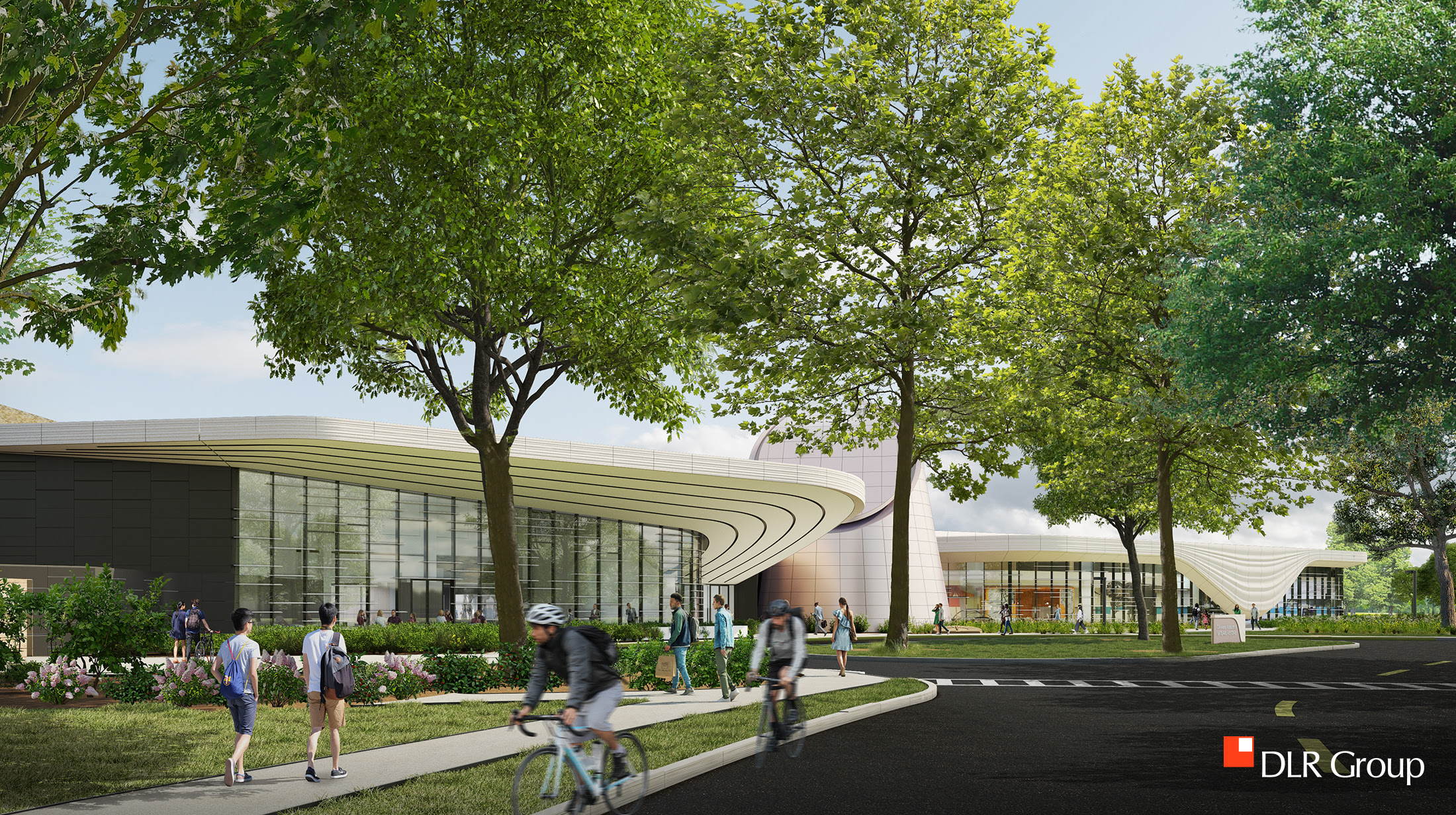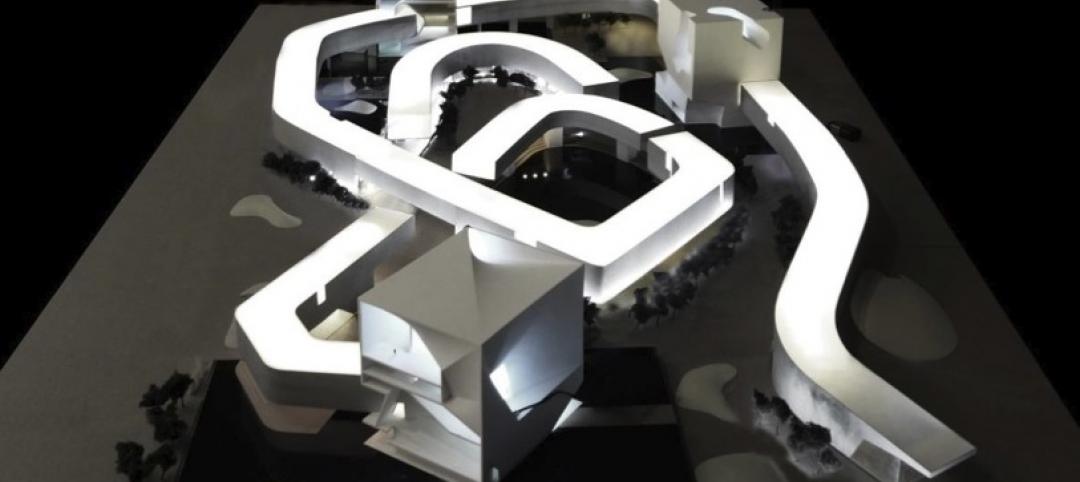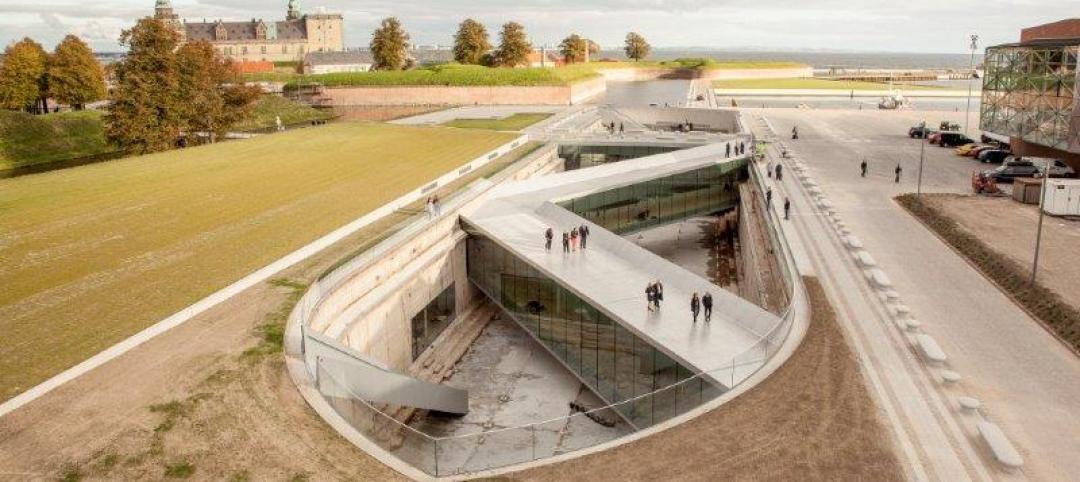Last December, the 100-year-old Cleveland Museum of Natural History completed an $8.9 million overhaul of its Thelma and Kent H. Smith Environmental Courtyard and the upgrade of its 450-seat Murch Auditorium. The courtyard was one of several “gateway” projects that have been interim stages of a $150 million expansion and renovation of the Museum, whose new 50,000-sf Exhibit Hall, main lobby, and café are scheduled to break ground this Thursday.
Sonia Winner, the Museum’s President and CEO, told the Cleveland Plain Dealer that the institution was also planning an $11.4 million upgrade of its central utility plant.
Since 1958, when the Museum moved to its current location, it has expanded at least six times. The latest expansion, designed by DLR Group, will feature a curving, snow-white roof made from cast-concrete panels and intended to evoke the glacier that covered Northeast Ohio during the last ice age. (Panzica Construction is the GC on this project.)
The museum’s latest expansion and renovation will create new exhibits, developed by Gallagher & Associates, and add curatorial posts for the purposes of connecting, in new ways, the Museum’s collections and research with public education and programming.
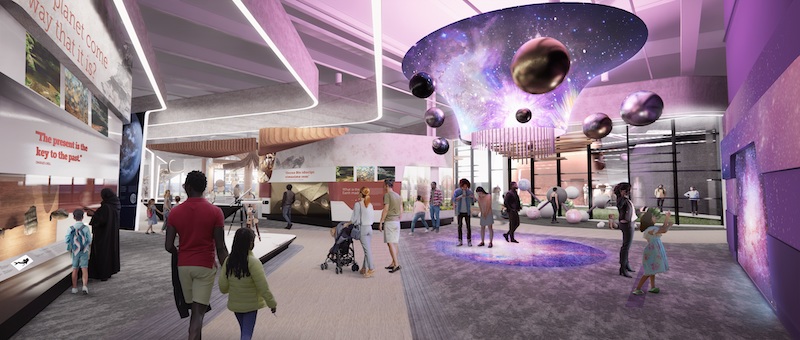
A rendering of the Museum's Planetary Process Gallery. The Museum's exhibit reorganization will attempt to connect humanity to the larger universe. Image: Gallagher & Associates
RETELLING HISTORY’S MARCH
The museum, which pre-pandemic was drawing 260,000 visitors annually, holds more than five million artifacts and specimens, and, through its Natural Areas program, stewards more than 11,000 acres of nature preserve in Northeast Ohio. Massive new exterior glass walls will wrap around the addition’s façade to open sightlines between the exhibits and the surrounding landscape of Wade Oval.
Inside, the traditional museum organization—by time period, geography, and species—is being deconstructed to tell integrated stories of planetary and biological processes.
The goal of this “reinvention” is to show more clearly how humanity intersects with the continuum of life on Earth and universal forces.
“We are creating a new model for natural history museums that uses the past to inform our present to build a better future together,” explains Winner. “Our reimagined museum will illuminate the interconnectedness of human life and the natural world, and how science is essential to our lives.”
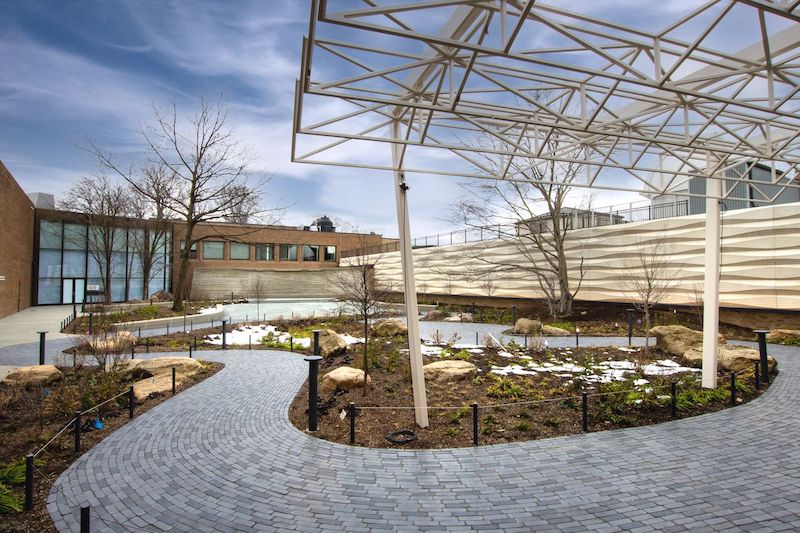
An “environmental courtyard,” which received an $8.9 million makeover, now serves as one of the Museum's gateways. Image: Cleveland Museum of Natural History
EVOLUTION ON DISPLAY
The museum addition (parts of which are scheduled to open next year) is being constructed on what currently is a parking lot, and will include a central welcome and orientation area, another gateway. The new Visitors Hall will feature a reconstruction of “Lucy,” the 3.2-million-year-old human ancestor that a team of Cleveland museum scientists first discovered 45 years ago, as well as a geological sample collected from the Moon, and specimens of modern-day animals to illustrate evolutionary and biological changes.
A new self-guided interactive space, The Ames Family Curiosity Center, is meant to connect the museum’s collections with its visitors’ lived experiences and global science-related news.
The addition and renovation should be completed sometime in 2024.

Each of the Museum's exhibitions will be part of a larger evolutionary story. Image: DLR Group
Related Stories
| Nov 25, 2013
Building Teams need to help owners avoid 'operational stray'
"Operational stray" occurs when a building’s MEP systems don’t work the way they should. Even the most well-designed and constructed building can stray from perfection—and that can cost the owner a ton in unnecessary utility costs. But help is on the way.
| Nov 19, 2013
Top 10 green building products for 2014
Assa Abloy's power-over-ethernet access-control locks and Schüco's retrofit façade system are among the products to make BuildingGreen Inc.'s annual Top-10 Green Building Products list.
| Nov 13, 2013
Installed capacity of geothermal heat pumps to grow by 150% by 2020, says study
The worldwide installed capacity of GHP systems will reach 127.4 gigawatts-thermal over the next seven years, growth of nearly 150%, according to a recent report from Navigant Research.
| Nov 13, 2013
First look: Renzo Piano's addition to Louis Kahn's Kimbell Art Museum [slideshow]
The $135 million, 101,130-sf colonnaded pavilion by the famed architect opens later this month.
| Oct 30, 2013
15 stellar historic preservation, adaptive reuse, and renovation projects
The winners of the 2013 Reconstruction Awards showcase the best work of distinguished Building Teams, encompassing historic preservation, adaptive reuse, and renovations and additions.
| Oct 30, 2013
Steven Holl selected for Culture and Art Center in Qingdao, besting Zaha Hadid, OMA
Steven Holl Architects has been selected by near unanimous jury decision as the winner of the new Culture and Art Center of Qingdao City competition, besting OMA and Zaha Hadid Architects. The 2 million-sf project for four museums is the heart of the new extension of Qingdao, China, planned for a population of 700,000.
| Oct 30, 2013
11 hot BIM/VDC topics for 2013
If you like to geek out on building information modeling and virtual design and construction, you should enjoy this overview of the top BIM/VDC topics.
| Oct 29, 2013
BIG opens subterranean Danish National Maritime Museum [slideshow]
BIG (Bjarke Ingels Group) has completed the Danish National Maritime Museum in Helsingør. By marrying the crucial historic elements with an innovative concept of galleries and way-finding, BIG’s renovation scheme reflects Denmark's historical and contemporary role as one of the world's leading maritime nations.
| Oct 28, 2013
Urban growth doesn’t have to destroy nature—it can work with it
Our collective desire to live in cities has never been stronger. According to the World Health Organization, 60% of the world’s population will live in a city by 2030. As urban populations swell, what people demand from their cities is evolving.
| Oct 18, 2013
Researchers discover tension-fusing properties of metal
When a group of MIT researchers recently discovered that stress can cause metal alloy to fuse rather than break apart, they assumed it must be a mistake. It wasn't. The surprising finding could lead to self-healing materials that repair early damage before it has a chance to spread.


